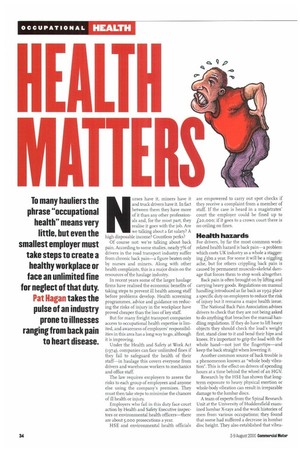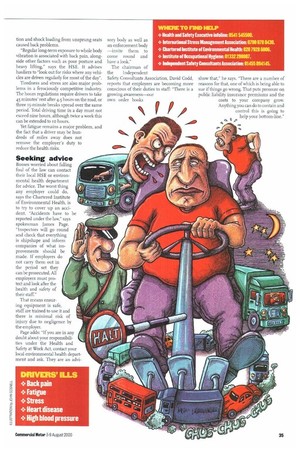HEALTH
Page 36

Page 37

If you've noticed an error in this article please click here to report it so we can fix it.
MATTERS
To many hauliers the phrase "occupational health" means very little, but even the smallest employer must take steps to create a healthy workplace or face an unlimited fine for neglect of that duty. Pat Hagan takes the pulse of an industry prone to illnesses ranging from back pain to heart disease.
Nurses have it, miners have it and truck drivers have it. In fact between them they have more of it than any other professionals and, for the most part, they realise it goes with the job. Are we talking about a fat salary? A high disposable income? Countless perks?
Of course not: we're talking about back pain. According to some studies, nearly 7% of drivers in the road transport industry suffer from chronic back pain—a figure beaten only by nurses and miners. Along with other health complaints, this is a major drain on the resources of the haulage industry.
In recent years some of the larger haulage firms have realised the economic benefits of taking steps to prevent ill health among staff before problems develop. Health screening programmes, advice and guidance on reducing the risks of injury in the workplace have proved cheaper than the loss of key staff.
But for many freight transport companies access to occupational health expertise is limited, and awareness of employers' responsibilities in this area has a long way to go, although it is improving.
Under the Health and Safety at Work Act (1974), companies can face unlimited fines if they fail to safeguard the health of their staff—in haulage this covers everyone from drivers and warehouse workers to mechanics and office staff The law requires employers to assess the risks to each group of employees and anyone else using the company's premises. They must then take steps to minimise the chances of ill health or injury.
Employers who fail in this duty face court action by Health and Safety Executive inspectors or environmental health officers—there are about 5,000 prosecutions a year.
HSE and environmental health officials are empowered to carry out spot checks if they receive a complaint from a member of staff. If the case is heard in a magistrates' court the employer could be fined up to £20,000; if it goes to a crown court there is no ceiling on fines.
Health hazards
For drivers, by far the most common workrelated health hazard is back pain—a problem which costs UK industry as a whole a staggering kbn a year. For some it will be a niggling ache, but for others crippling back pain is caused by permanent musc-ulo-skeletal damage that forces them to stop work altogether.
Back pain is often brought on by lifting and carrying heavy goods. Regulations on manual handling introduced as far back as 1992 place a specific duty on employers to reduce the risk of injury but it remains a major health issue.
The National Back Pain Association advises drivers to check that they are not being asked to do anything that breaches the manual handling regulations. If they do have to lift heavy objects they should check the load's weight first, stand close to it and bend their hips and knees. It's important to grip the load with the whole hand—not just the fingertips—and keep the back straight when lowering it.
Another common source of back trouble is a phenomenon known as "whole body vibration". This is the effect on drivers of spending hours at a time behind the wheel of an HGV Research by the H SE has shown that longterm exposure to heavy physical exertion or whole-body vibration can result in irreparable damage to the lumbar discs.
A team of experts from the Spinal Research Unit at the University of Huddersfield examined lumbar X-rays and the work histories of men from various occupations; they found that some had suffered a decrease in lumbar disc height. They also established that vibra
tion and shock loading from unsprung seats caused back problems.
"Regular long-term exposure to whole body vibration is associated with back pain, alongside other factors such as poor posture and heavy lifting," says the H SE. It advises hauliers to "look out for risks where any vehicles are driven regularly for most of the day".
Tiredness and stress are also major problems in a ferociously competitive industry. The hours regulations require drivers to take 45 minutes rest after 4.5 hours on the road, or three 15-minute breaks spread over the same period. Total driving time in a day must not exceed nine hours, although twice a week this can be extended to TO hours.
Yet fatigue remains a major problem, and the fact that a driver may be hun dreds of miles away does not remove the employer's duty to reduce the health risks.
Seeking advice
Bosses worried about falling foul of the law can contact their local HSE or environmental health department for advice. The worst thing any employer could do, says the Chartered Institute of Environmental Health, is to try to cover up an accident. "Accidents have to be reported under the law," says spokesman James Page. "Inspectors will go round and check that everything is shipshape and inform companies of what improvements should he made. If employers do not carry them out in the period set they can be prosecuted. All employers must protect and look after the health and safety of their staff."
That means ensuring equipment is safe, staff are trained to use it and there is minimal risk of injury due to negligence by the employer.
Page adds: "If you are in any doubt about your responsibilities under the Health and Safety at Work Act, contact your local environmental health department and ask. They are an advi sory body as well as an enforcement body —invite them to come round and have a look."
The chairman of the independent Safety Consultants Association, David Codd, reports that employers are becoming more conscious of their duties to staff: "There is a growing awareness—our own order books show that," he says. "There are a number of reasons for that, one of which is being able to sue if things go wrong. That puts pressure on public liability insurance premiums and the costs to your company grow. Anything you can do to contain and control this is going to help your bottom-line."




































































































